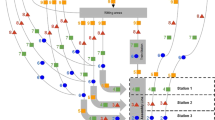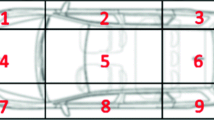Abstract
The customization of final products in the automotive industry involves a large number of optional parts and leads to a huge variety of operation times at the various stations of the assembly line. The master production scheduling problem (MPS) for high-variant mixed-model assembly lines is to assign the individual customer-defined models of a basic product type to short-term production periods while anticipating the negative impacts of an unbalanced model sequence at the lower planning level. We propose a mathematical model formulation for the MPS and develop heuristic solution procedures that attempt to minimize the workload variability. Specifically, these procedures anticipate decisions on the mixed-model sequence and the resulting work overload at stations which has to be balanced by the assignment of utility workers. Furthermore, an integrated planning approach for solving the MPS and the production sequencing problem is proposed.








Similar content being viewed by others
References
Becker C, Scholl A (2006) A survey on problems and methods in generalized assembly line balancing. Eur J Oper Res 168(3):694–715
Bolat A (2003) A mathematical model for selecting mixed models with due dates. Int J Prod Res 41(5):897–918
Boysen N (2005) Variantenfließfertigung. Gabler, Wiesbaden (in German)
Boysen N, Fliedner M, Scholl A (2009a) Production planning of mixed model assembly lines: overview and extensions. Prod Plann Control 20(5):455–471
Boysen N, Fliedner M, Scholl A (2009b) Sequencing mixed-model assembly lines: survey, classification and model critique. Eur J Oper Res 192(2):349–373
Boysen N, Fliedner M, Scholl A (2009c) Level scheduling for batched JIT supply. Flex Serv Manuf 21(1–2):31–50
Boysen N, Fliedner M, Scholl A (2010) Level scheduling under limited resequencing flexibility. Flex Serv Manuf 22(3–4):236–257
Ding FY, Tolani R (2003) Production planning to support mixed-model assembly. Comput Ind Eng 45(3):375–392
Garcia-Sabater J-P, Maheut J, Garcia-Sabater JJ (2012) A two-stage sequential planning scheme for integrated operations planning and scheduling system using MILP: the case of an engine assembler. Flex Serv Manuf 24(2):171–209
Garey MR, Johnson DS (1979) Computers and intractability: a guide to the theory of NP-completeness. W.H. Freeman & Co, New York
Golle U, Boysen N, Rothlauf F (2010) Analysis and design of sequencing rules for car sequencing. Eur J Oper Res 206(3):579–585
Golz J, Gujjula R, Günther H-O, Rinderer S, Ziegler M (2012) Part feeding at high-variant mixed-model assembly lines. Flex Serv Manuf 24(2):119–141
Gujjula R, Günther H-O (2009) Scheduling utility workers at mixed-model assembly lines. In: Proceedings of the 2009 IEEE international conference on industrial engineering and engineering management. Sun H, Jiao R and Xie M (eds), IEEE, Singapore 2009, pp. 1092–1096
Gujjula, R., Günther, H.-O. (2010), An efficient heuristic to sequence mixed-model assembly lines. In: Proceedings of the 2010 IEEE international conference on industrial engineering and engineering management. Lian Z, Wu Z, Min X, Jiao R (eds). IEEE, Singapore 2010, pp 1209–1209
Gujjula R, Werk S, Günther H-O (2011) A heuristic based on Vogel’s approximation method for sequencing mixed-model assembly lines. Int J Prod Res 49(21):6451–6468
Hindi KS, Ploszajski G (1994) Formulation and solution of a selection and sequencing problem in car manufacture. Comput Ind Eng 26(1):203–211
Lesert A, Alpan G, Frein Y, Noiré S (2011) Definition of spacing constraints for the car sequencing problem. Int J Prod Res 49(2):963–994
Meyr H (2004) Supply chain planning in the German automotive industry. OR Spectrum 26(4):447–470
Schneeweiß C (2003) Distributed decision making, 2nd edn. Springer, Heidelberg
Volling T (2009) Auftragsbezogene Planung bei variantenreicher Serienproduktion. Gabler, Wiesbaden (in German)
Volling T, Spengler T (2011) Modelling and simulation of order-driven planning policies in built-to-order automobile production. Int J Prod Econ 131(1):183–193
Volling T, Matzke A, Grunewald M, Spengler TS (2012) Planning of capacities and orders in build-to-order automobile production: a review. Eur J Oper Res. to appear (available online: doi:10.1016/j.ejor.2012.07.034)
Zeramdini W, Aigbedo H, Monden Y (2000) Bicriteria sequencing for just-in-time mixed-model assembly lines. Int J Prod Res 38(15):451–3470
Author information
Authors and Affiliations
Corresponding author
Appendices
Appendix A
Notation
Sets | |
O | The set of orders |
S | The set of stations at the assembly line |
T | The set of planning periods |
\( i = \left\{ {1 \ldots N} \right\} \) | The intervals of processing times in the PIA heuristic |
\( \tau = \left\{ {1 \ldots C} \right\} \) | The set of production cycles |
Parameters | |
a os | Processing time of order \( o \in O \) at station \( s \in S \) |
\( A_{st}^{k - 1} \) | Workload assigned to station s in Period t until iteration k-1 |
\( AVG_{s} = \frac{{\sum\nolimits_{o \in O} {a_{os} } }}{\left| O \right|} \) | Average workload of station \( s \in S \) in the order bank |
\( b_{ios} \) | Binary parameter indicating if order o is in interval i at station s |
BigM | A sufficiently large number |
C | Number of production cycles per period |
\( c_{ot}^{k} ,\;c_{ot}^{\prime k} \) | Cost of assigning order o to period t in iteration k |
\( e_{s} \) | Feasible deviation from the average workload in station \( s \in S \) |
\( g^{k} \) | Fraction of assigned orders after iteration k |
\( IB_{ot}^{k} \) | Workload imbalance caused by order o in period t in iteration k |
\( IW_{s} \) | Interval width of processing times at station \( s \in S \) |
\( l_{s} \) | Length of station \( s \in S \) |
\( N \) | The number of processing time intervals per station and period |
\( R_{ist}^{k} \) | Ratio of orders which have been assigned after iteration k to interval i and station s in period t |
\( TR_{is} \) | Target ratio of orders contained in interval i at station s |
\( u_{os\tau }^{k} \) | Total utility work of order o in production cycle τ in period t in iteration k |
\( \tilde{u}_{os\tau t}^{k} \) | Utility work at station s in production cycle τ in period t if candidate order o has been chosen in iteration k |
\( v_{os\tau }^{k} \) | Total idle time of order o in production cycle τ in period t in iteration k |
\( \tilde{v}_{os\tau t}^{k} \) | Idle time at station s in production cycle τ in period t if candidate order o has been chosen in iteration k |
\( \tilde{w}_{os\tau t}^{k} \) | Worker position at station s at the start of production cycle τ in period t if candidate order o has been chosen in iteration k |
\( \alpha_{is} \) | Weight assigned to interval i and station s |
\( \gamma_{1} \), \( \gamma_{2} \), \( \gamma_{3} \) | Weights assigned to terms of the cost coefficient |
λ | Cycle time |
Variables | |
\( h_{ist} \ge 0 \) | Continuous variable which represents the deviation of the actual ratio of orders in station s and interval i from the target ratio in period t |
\( mw \ge 0 \) | Continuous variable which represents the maximum workload over all stations and periods |
\( p_{st} \in \left\{ {0,1} \right\} \) | Binary variable which is set to 1 if the workload at station s in period t exceeds the feasible boundaries |
\( u_{s\tau t} \ge 0 \) | Continuous variable which represents the work overload at station s in production cycle τ in period t |
\( w_{s\tau t} \ge 0 \) | Continuous variable which represents the worker position at station s at the start of production cycle τ in period t |
\( y_{ot} \in \left\{ {0,1} \right\} \) | Binary variable which is set to 1 if and only if order o is assigned to period t |
\( Y_{o\tau t} \in \left\{ {0,1} \right\} \) | Binary variable which is set to 1 if and only if order o is assigned to cycle τ in period t |
\( MLC_{s} \ge 0 \) | Continuous variable which represents the maximum workload of station s over all periods |
\( z_{s} \ge 0 \) | Continuous variable which represents the gap between the maximal and minimal workload station s |
Appendix B: Proof of NP completeness
In the following it is shown that the MPS with the DWB objective (MPS-D-DWB) is NP-complete in the strong sense by reducing it to the well known 3-partition problem.
Given a number B, the decision problem related to the MPS (MPS-D) with an objective function z is to answer the following question:
-
Exists a feasible schedule x with an objective value \( z(x) \le B \)?
Since a given schedule can be evaluated in polynomial time, MPS-D belongs to NP.
The 3-partition can be formulated as follows. Let \( A = \left\{ {a_{1} , \ldots ,a_{3m} } \right\} \) be a set of 3m positive integers. The problem is to determine m disjoint subsets, \( S_{1} , \ldots ,S_{m} \), each containing exactly 3 elements and with an equal weight: \( \sum\nolimits_{{a_{i} \in S_{1} }} {a_{i} } = \ldots = \sum\nolimits_{{a_{i} \in S_{m} }} {a_{i} } \).
The solution is yes if such a partition exists and no otherwise.
To reduce the MPS to the 3-partition problem it is to be proofed that an instance of the MPS can be linearly transformed into an instance of the 3-partition problem and if and only if the answer to the question of the MPS-D is yes the answer to the corresponding 3-partition problem is yes, as well.
For an instance of the 3-partition problem generate an instance of the MPS-D-DWB problem with an assembly line consisting of one single station, an order \( o_{i} \) for every integer \( a_{i} \) with a processing time of a 1 time units, m periods with a capacity of 3 Units and set B equal to 0. Obviously, this transformation is linear. Given a feasible schedule of the MPS-D-DWB the subsets \( S_{1} \ldots S_{m} \) can easily be generated by identifying every set with a period and assigning the numbers represented by the respective orders. If the answer to the MPS-D is yes, every period has an equal workload. Consequently, the answer to the respective 3-partition problem is yes. Conversely, if a 3-partition exists, the subsets define a feasible solution to the MPS-D-DWB problem. Hence, the MPS-D-DWB problem is as complex as the 3-partition problem which is NP complete in the strong sense (cf. Garey and Johnson 1979).
The preceding proof can easily be adopted according to the IWB, MMW and PIA objectives of the MPS.
Rights and permissions
About this article
Cite this article
Dörmer, J., Günther, HO. & Gujjula, R. Master production scheduling and sequencing at mixed-model assembly lines in the automotive industry. Flex Serv Manuf J 27, 1–29 (2015). https://doi.org/10.1007/s10696-013-9173-8
Published:
Issue Date:
DOI: https://doi.org/10.1007/s10696-013-9173-8




